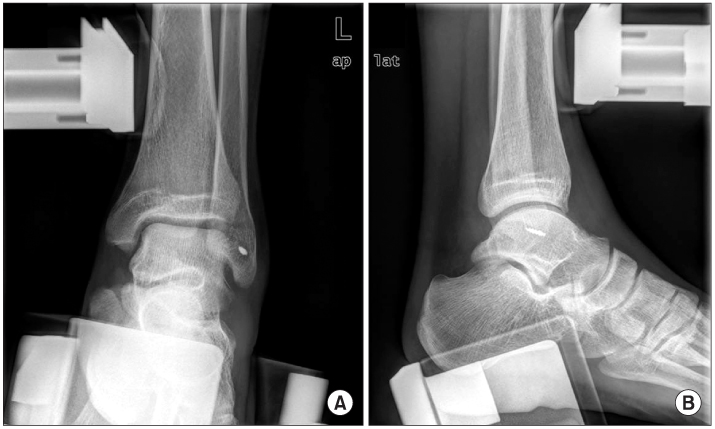J Korean Orthop Assoc.
2010 Feb;45(1):16-23. 10.4055/jkoa.2010.45.1.16.
Outcomes of the Modified-Brostrom Procedure Using Suture Anchor for Chronic Lateral Ankle Instability: a Prospective, Randomized Comparison with the Bone Tunnel Technique
- Affiliations
-
- 1Department of Orthopaedic Surgery, Chungbuk National University College of Medicine, Cheongju, Korea. titanick25@yahoo.co.kr
- KMID: 2185589
- DOI: http://doi.org/10.4055/jkoa.2010.45.1.16
Abstract
- PURPOSE
This study was performed prospectively and randomly to compare the clinical outcomes of modified-Brostrom procedures using the suture anchor and the bone tunnel for chronic lateral ankle instability.
MATERIALS AND METHODS
Thirty patients were followed up for more than 1 year after the modified-Brostrom procedures. Fifteen procedures treated with a suture anchor and 15 procedures treated with a bone tunnel technique assigned randomly were performed by a single surgeon. The clinical evaluation was performed according to the VAS for pain, the Karlsson scale and Sefton grading system. Measurements of the talar tilt and anterior talar translation was performed using anterior and varus stress radiographs.
RESULTS
There were no significant differences in the pain VAS between the 2 techniques postoperatively. However, the pain VAS at postoperative 4th day was significantly higher in the bone tunnel group. The Karlsson scale had improved significantly from a preoperative average of 45.2 points to 90.1 points in the suture anchor group, and from 44.6 points to 88.3 points in the bone tunnel group. According to the Sefton grading system, 13 cases (86.7%) in the suture anchor group and 12 cases (80%) in the bone tunnel group achieved satisfactory results. The talar tilt angle and anterior talar translation had improved significantly from preoperative average of 14.2degrees and 6.2 mm to 6.4degrees and 4.5 mm in the suture anchor group, from 13.8degrees and 6.4 mm to 6.1degrees and 4.2 mm in the bone tunnel group. There were no significant differences between 2 techniques.
CONCLUSION
The techniques for ligament reattachment produced similar clinical and functional outcomes except for early-stage postoperative pain. Both modified-Brostrom procedures using the suture anchor and bone tunnel appear to be effective treatment methods for chronic lateral ankle instability. However, the suture anchor technique has an advantage of less early-stage postoperative pain.
MeSH Terms
Figure
Cited by 1 articles
-
Treatment of Chronic Lateral Ankle Instability: A Modified Broström Technique Using All-Suture Anchor
Sungjoon Lim, Nam Jun Baek, Geon Jung Kim
Korean J Sports Med. 2024;42(2):119-125. doi: 10.5763/kjsm.2024.42.2.119.
Reference
-
1. Gerber JP, Williams GN, Scoville CR, Arciero RA, Taylor DC. Persistent disability associated with ankle sprains. A prospective examination of an athletic population. Foot Ankle Int. 1998. 19:653–660.
Article2. Hamilton WG, Thompson FM, Snow WS. The modified Brostrom procedure for lateral ankle instability. Foot Ankle. 1993. 14:1–7.
Article3. Karlsson J, Bergsten T, Lansinger O, Peterson L. Reconstruction of the lateral ligaments of the ankle for chronic lateral instability. J Bone Joint Surg Am. 1988. 70:581–588.
Article4. Karlsson J, Eriksson BI, Bergsten T, Rudholm O, Swärd L. Comparison of two anatomic reconstructions for chronic lateral instability of the ankle joint. Am J Sports Med. 1997. 25:48–53.
Article5. Hennrikus WL, Mapes RC, Lyons PM, Lapoint JM. Outcomes of the Chrisman-Snook and modified Brostrom procedures for chronic lateral ankle instability. A prospective, randomized comparison. Am J Sports Med. 1996. 24:400–404.6. Ahn JH, Lee YG, Jung SH, Choy WS. Treatment of chronic ankle lateral instability using modified Brostrom procedure. J Korean Orthop Assoc. 2007. 42:91–97.
Article7. Hess A, Caborn D, Rehak D, Harner CD, Fu FH. Surgical treatment of chronic lateral ankle instability using the mitek suture anchors system. Pittsburgh Orthopaedic Journal. 1991. 2:54–59.8. Karlsson J, Peterson L. Evaluation of ankle joint function The use of a scoring scale. The Foot. 1991. 1:15–19.
Article9. Sefton GK, George J, Fitton JM, McMullen H. Reconstruction of the anterior talofibular ligament for the treatment of the unstable ankle. J Bone Joint Surg Br. 1979. 61:352–354.
Article10. Messer TM, Cummins CA, Ahn J, Kelikian AS. Outcome of the modified brostrom procedure for chronic lateral ankle instability using suture anchors. Foot Ankle Int. 2000. 21:996–1003.11. Paden MH, Stone PA, McGarry JJ. Modified brostrom lateral ankle stabilization utilizing an implantable anchoring system. J Foot Ankle Surg. 1994. 33:617–622.12. Gould N, Seligson D, Gassman J. Early and late repair of lateral ligament of the ankle. Foot Ankle. 1980. 1:84–89.
Article13. Berlet GC, Anderson RB, Davis WH. Chronic lateral ankle instability. Foot Ankle Clin. 1999. 4:713–728.14. Cox JS, Hewes TF. Normal talar tilt angle. Clin Orthop Relat Res. 1979. 140:37–41.
Article15. Rubin G, Witten M. The talar tilt angle and the fibular collateral ligaments. J Bone Joint Surg Am. 1960. 42:311–326.16. Karlsson J, Lansinger O. Lateral instability of the ankle joint. Clin Orthop Relat Res. 1992. 276:253–261.
Article17. Kitaoka HB, Lee MD, Morrey BF, Cass JR. Acute repair and delayed reconstruction for lateral ankle instability: twenty-year follow-up study. J Orthop Trauma. 1997. 11:530–535.
Article18. Park YW, Park IH, Yoo JH, Park HJ, Yu SO, Kim GL. Comparison of results obtained from the modified Brostrom and the Chrisman-Snook procedures for chronic lateral ankle instability. J Korean Orthop Assoc. 2001. 36:403–408.
Article19. Cass JR, Morrey BF, Katoh Y, Chao EY. Ankle instability: comparison of primary repair and delayed reconstruction after long term follow-up study. Clin Orthop Relat Res. 1985. 198:110–117.
- Full Text Links
- Actions
-
Cited
- CITED
-
- Close
- Share
- Similar articles
-
- Modified Brostrom Procedure with Suture Anchor & PushLock Anchor in Lateral Ankle Instability
- Surgical Outcomes of Arthroscopic Modified Brostrom Procedure in Chronic Lateral Ankle Instability
- Anatomical Repair for Chronic Lateral Ankle Instability
- Treatment of Chronic Lateral Ankle Instability: A Modified Broström Technique Using All-Suture Anchor
- Treatment of Chronic Ankle Lateral Instability using Modified Brostrom Procedure with Anchor suture&Arthroscopy





